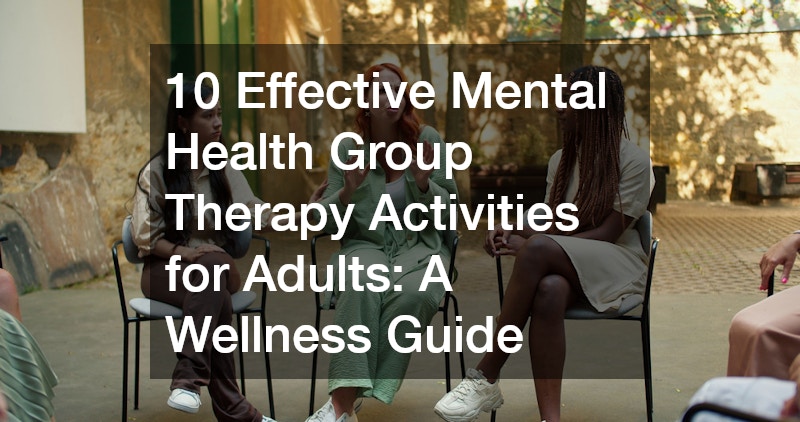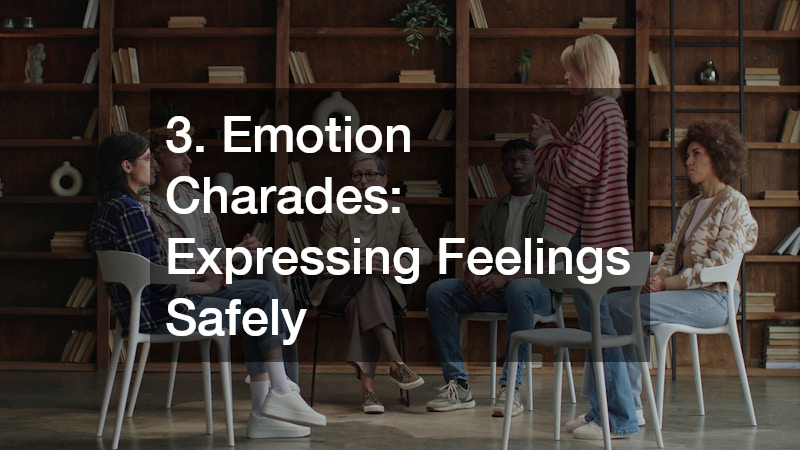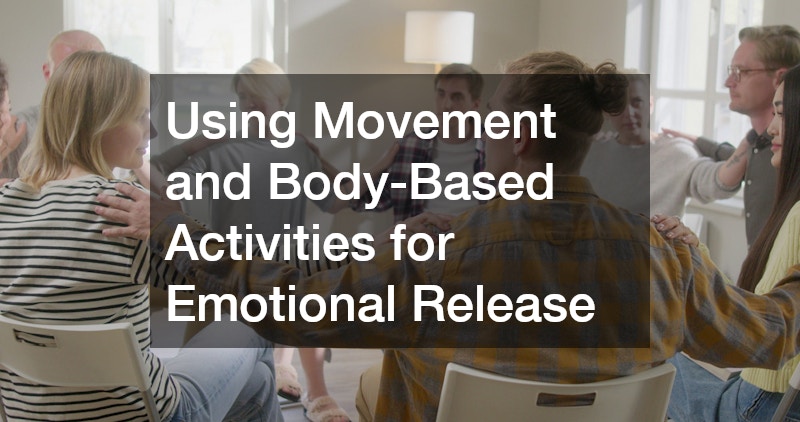10 Effective Mental Health Group Therapy Activities for Adults: A Wellness Guide
In a world that often demands emotional resilience and constant productivity, adults face mounting pressures that can negatively affect their mental well-being. Group therapy offers a supportive and structured environment for adults to explore their emotions, share experiences, and build interpersonal skills. When guided effectively, mental health group therapy activities serve as powerful tools for fostering connection, self-awareness, and healing.
Unlike traditional talk therapy, group sessions provide a sense of shared understanding and collective growth. Engaging in interactive activities can ease social barriers, promote self-expression, and equip adults with coping skills that extend beyond the therapy room. Whether dealing with anxiety, depression, trauma, or social isolation, structured group therapy activities play a vital role in recovery and empowerment.
In this article, we explore 10 effective mental health group therapy activities for adults, explain how they benefit emotional well-being, and offer practical insights for facilitators and participants alike.
1. Icebreaker Activities: Building Safety and Trust
Before diving into deep emotional topics, it’s essential to create a safe, welcoming environment. Icebreaker activities are a great way to reduce anxiety, introduce participants, and encourage initial interaction.
Examples of adult-friendly icebreakers:
- Two Truths and a Lie – Each person shares three statements; the group guesses which one is false.
- Common Ground – Participants find three things they all have in common.
- Personal Objects – Ask participants to bring an object from home and explain its meaning.
Why it works:
Icebreakers humanize the group, promote lighthearted interaction, and help adults feel seen and heard. By starting with simple sharing, participants begin forming bonds that set the foundation for deeper therapeutic work.
2. Mindfulness and Grounding Exercises
Mindfulness is a proven technique for reducing anxiety and increasing emotional regulation. Introducing grounding exercises in group therapy can help adults stay present and feel more in control during sessions.
Try these activities:
- 5-4-3-2-1 Grounding Technique – A sensory check-in using sight, sound, touch, smell, and taste.
- Guided Body Scan Meditation – Direct attention to various body parts, reducing tension.
- Breathing Circles – The group synchronizes deep breathing to promote calm.
Therapeutic value:
Grounding techniques are especially beneficial for adults coping with stress, panic, or trauma. They also help center the group, fostering a calm collective space where everyone feels secure.
3. Emotion Charades: Expressing Feelings Safely
Many adults struggle to express emotions clearly or may feel vulnerable doing so. Emotion charades is a playful yet effective way to help participants become more aware of their emotional vocabulary and body language.
How to play:
- Write various emotions (e.g., shame, joy, frustration, contentment) on slips of paper.
- One person picks a slip and acts out the emotion non-verbally.
- The group guesses the emotion and discusses situations where they’ve felt it.
Why this helps:
This activity not only promotes emotional literacy but also opens up dialogue around feelings that are often buried or stigmatized. It also helps identify behavioral patterns tied to specific emotions.
4. Story Circles: Shared Narratives for Healing
Sharing personal stories in a supportive group setting can be deeply healing. Story circles invite adults to speak about life events, challenges, or victories in a structured, respectful space.
Facilitation tips:
- Set a time limit for each participant (e.g., 3-5 minutes).
- Use prompts like “A moment I felt truly seen…” or “A time I overcame adversity.”
- Encourage active listening with no interruptions.
Benefits:
This practice helps adults feel validated, heard, and less alone in their experiences. Storytelling also enhances empathy among group members and reinforces a sense of belonging.
5. Vision Boarding: Creative Expression for Future Goals
Art-based therapy activities provide a nonverbal outlet for emotions and dreams. Vision boarding allows adults to explore goals, values, and aspirations through imagery and collage.
Materials you’ll need:
- Magazines, scissors, glue, markers, poster boards
- Optional: relaxing music, thematic prompts like “Where I see myself in a year”
Therapeutic outcomes:
Creating vision boards activates the imagination and opens participants to new possibilities. It shifts focus from problems to potential, promoting hope and motivation.
6. Group Journaling and Reflection
Journaling helps clarify thoughts, process emotions, and track progress. In a group therapy context, it becomes even more powerful when combined with guided prompts and shared reflections.
Activity format:
- Provide prompts like:
- “Today, I feel…”
- “What I wish others knew about me…”
- “A belief I want to challenge is…”
- Allow 10–15 minutes for writing.
- Optional: Volunteers can read their entries aloud.
Therapeutic impact:
This structured self-expression fosters introspection and courage. When shared, it nurtures empathy and breaks down emotional walls between group members.
7. Role-Playing Scenarios for Real-Life Challenges
Role-playing is an excellent way to practice social skills, conflict resolution, and assertive communication. It allows participants to rehearse difficult conversations or explore alternate perspectives in a safe setting.
Example scenarios:
- Setting boundaries with a friend or coworker
- Asking for support from a loved one
- Responding to criticism without shutting down
Why it works:
Role-playing equips adults with practical tools for everyday challenges. It can increase confidence and help rewire unhelpful behavioral patterns through repetition and group feedback.
8. Gratitude Rounds: Cultivating Positivity
Gratitude has a well-documented effect on mental health, improving mood, resilience, and overall satisfaction. Incorporating gratitude rounds into group therapy promotes a positive mindset and strengthens social connection.
How to do it:
- Go around the circle, with each person sharing 1–3 things they are grateful for.
- Encourage variation: “Something I’m grateful for today,” “A person I appreciate,” “A lesson I’ve learned.”
Why this matters:
Especially in groups dealing with depression or burnout, focusing on gratitude shifts attention from deficits to strengths. It also models vulnerability and appreciation, which deepens group cohesion.
9. Feedback Circles: Constructive and Compassionate Insight
Receiving honest yet compassionate feedback can be transformative. Feedback circles allow participants to reflect on each other’s strengths and areas for growth in a guided, respectful format.
Structure:
- Begin with positive observations.
- Use “I” statements: “I noticed you were really present when I shared…”
- Keep feedback specific, nonjudgmental, and supportive.
Caution:
Ensure the group has already built trust. A skilled facilitator is essential to manage tone and redirect harmful language.
Benefits:
These sessions promote self-awareness, accountability, and deeper interpersonal learning—critical components of adult emotional development.
10. Mental Health Group Therapy Activities for Adults with Specific Needs
Not all group therapy activities suit every situation. It’s important to tailor exercises to the group’s shared challenges, such as anxiety, trauma, or substance use recovery.
For Anxiety:
- Progressive Muscle Relaxation (PMR)
Reduces tension by systematically tensing and relaxing muscle groups. - Worry Tree Worksheet
Helps identify and manage anxious thoughts through a decision-based flowchart.
For Trauma Survivors:
- Safe Place Visualization
A guided meditation where participants create a mental “safe space.” - Containment Exercises
Teaches how to mentally set aside distressing emotions until they can be processed safely.
For Substance Use Recovery:
- Triggers and Coping Skills Mapping
Participants identify triggers and brainstorm healthy coping mechanisms. - Relapse Role-Play
Practice refusal skills or navigate high-risk social settings through simulation.
Relevance:
Tailoring activities to specific emotional or behavioral challenges makes group therapy more effective, meaningful, and relatable for participants.
Incorporating Art Therapy in Group Sessions
Art therapy is a powerful medium for expression, especially for adults who may struggle to articulate their emotions verbally. In group settings, creative exercises help participants externalize inner conflicts, reduce anxiety, and foster non-verbal communication.
Examples of effective art therapy activities:
- Feelings Collage – Ask participants to cut out images from magazines that reflect their current emotions and arrange them into a collage.
- Mask Making – Create two-sided masks: one side representing how they present to the world, and the other showing their internal struggles.
- Emotion Mandalas – Use colors and shapes to represent different emotional states.
These activities support introspection while offering insight to group facilitators about the participant’s mental state and emotional themes.
Using Movement and Body-Based Activities for Emotional Release
Movement therapy in a group setting can release stored tension, promote embodiment, and support trauma recovery. Physical expression allows adults to process emotions that may be held in the body, especially valuable for those with histories of trauma or anxiety.
Movement-based group exercises:
- Mirroring Exercises – One person leads gentle movements, and others follow to build trust and awareness.
- Emotion Walks – Participants walk around the room acting out different emotional states (e.g., joy, fear, sadness).
- Group Stretching Circles – Gentle stretches coordinated as a group help release physical tension and improve collective focus.
These body-based activities can balance the cognitive load of talk therapy while grounding participants in the present moment.
Adapting Activities for Online or Virtual Group Therapy
With the rise of telehealth, many group therapy sessions now take place online. Adapting group activities for a virtual setting ensures engagement remains high, even when participants aren’t physically present.
Best practices for virtual group activities:
- Use breakout rooms for paired sharing or smaller group exercises.
- Share digital worksheets or use collaborative tools like Google Docs or Jamboard for journaling and feedback activities.
- Try virtual-specific exercises like “Zoom Show & Tell,” where participants share meaningful items from home to spark discussion.
- Leverage guided audio/visuals for mindfulness and grounding techniques.
Facilitators must ensure clear communication, strong tech support, and inclusive participation to maintain the emotional safety of online sessions.
Final Thoughts: Making Group Therapy a Safe Space for Growth
Group therapy for adults thrives on connection, creativity, and structure. The activities outlined above do more than just fill time—they offer adults a pathway to self-discovery, resilience, and community. Each session, guided with intention, becomes a space where vulnerability is honored, voices are heard, and healing begins.
Whether you’re a mental health professional, a group facilitator, or someone seeking support, these activities can bring life to the therapeutic process. They help adults not only cope with mental health challenges but also reclaim their agency, rediscover their values, and reconnect with others.



